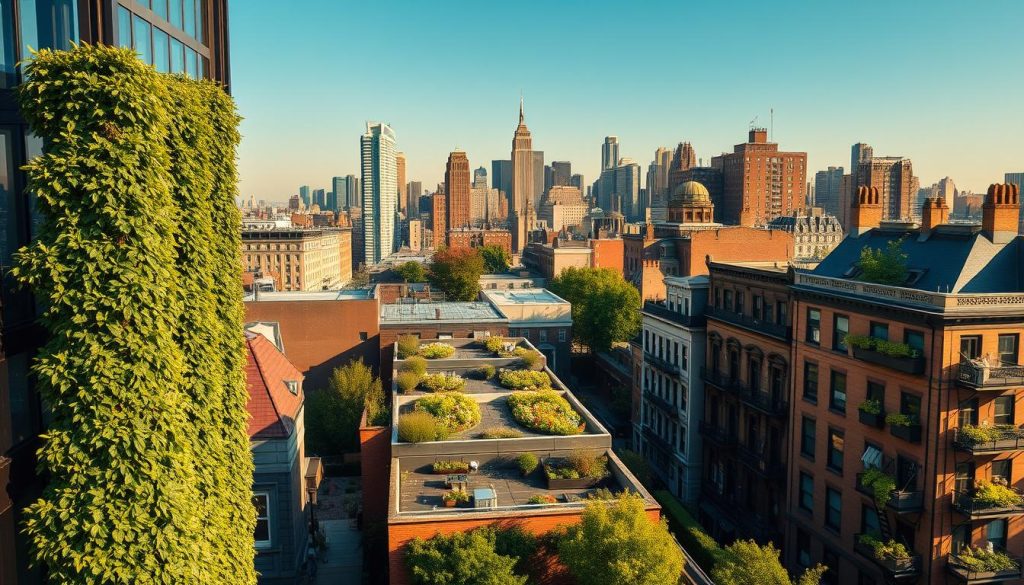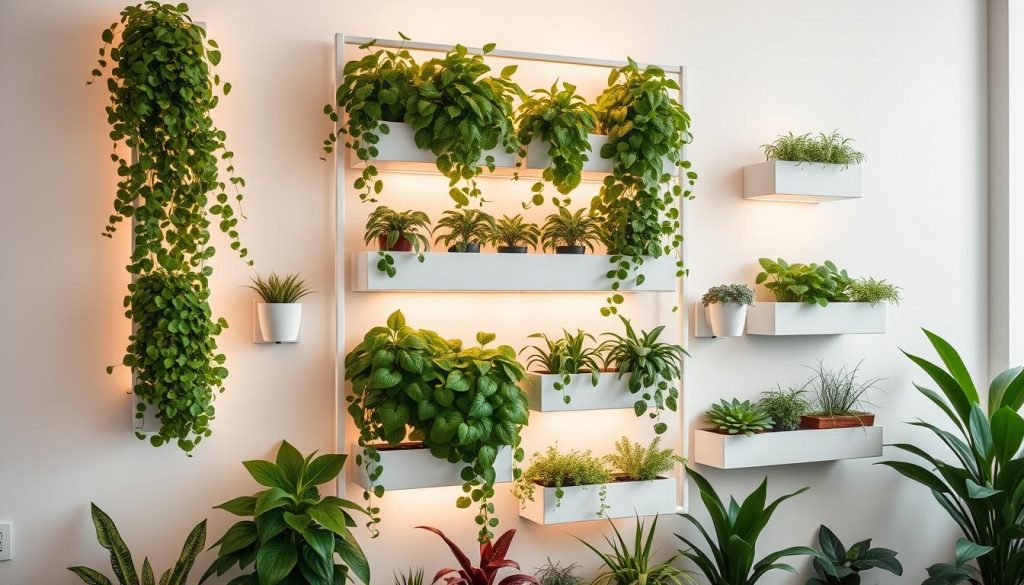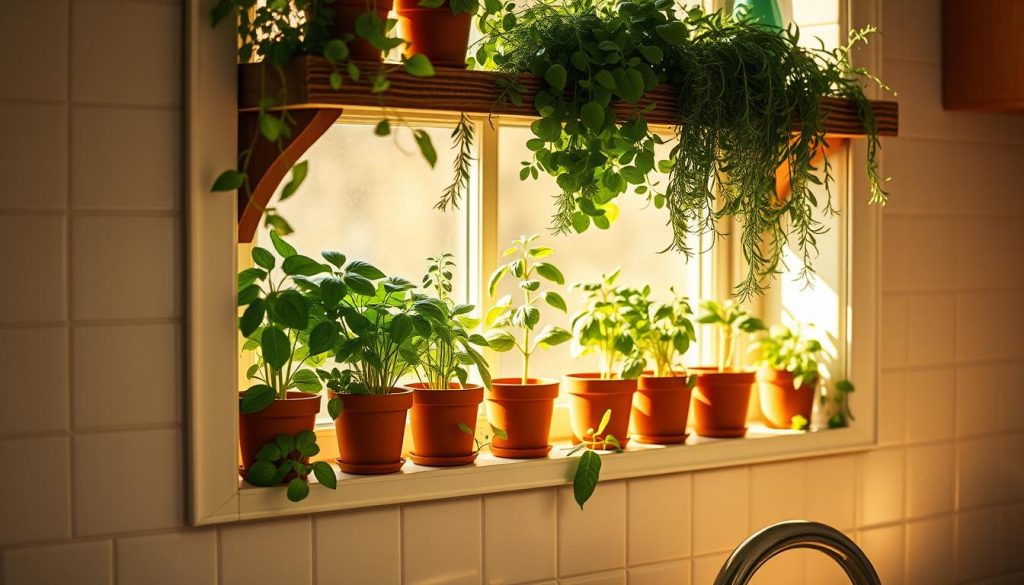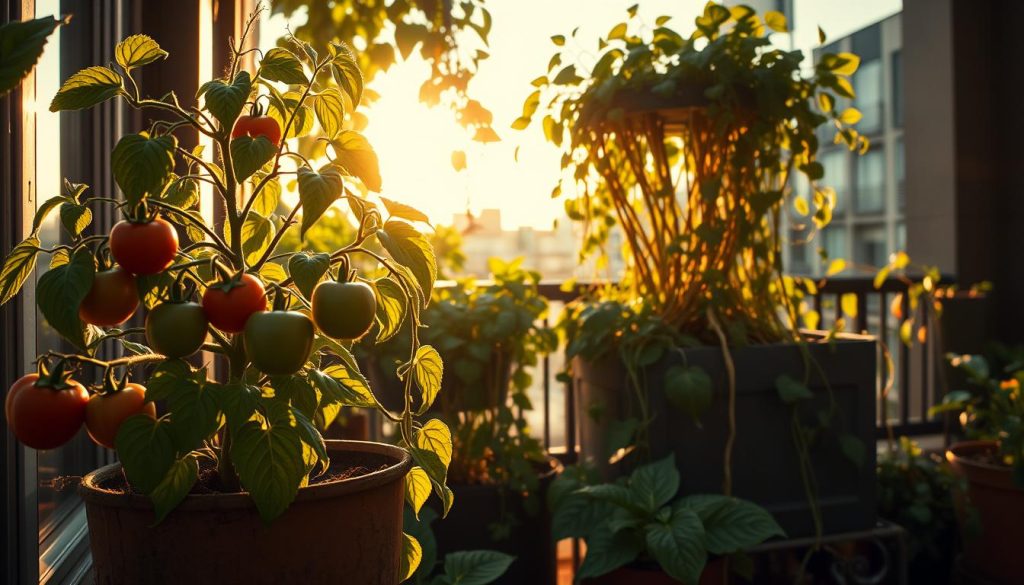Growing your own plants can seem hard if you live in a small place. But, small-space gardening has made it possible for many. Now, you can have green spaces almost anywhere – like balconies, patios, windowsills, and rooftops.
Compact planting is very flexible. You can grow herbs for cooking, colorful flowers, or even vegetables. With a few containers and some creativity, it’s all possible.
These methods do more than just grow food and flowers. They bring nature to city life, cut down grocery costs, and make peaceful green spots. Many find caring for their gardens boosts their mood and makes their homes better.
Whether you’re new to gardening or want to grow more, we’ve got you covered. We’ll share tips and strategies for any space. With the right approach, even the tiniest spot can become a lush garden.
The Growing Trend of Small-Space Gardening
A green revolution is happening in America’s apartments, balconies, and small yards. Small-space gardening is becoming popular everywhere. Over 35% of American households now garden at home, with urban and container gardening leading the way.
This growth shows how our living habits and values are changing. In a world where space is limited, we’re finding new ways to garden.
Seed companies have seen sales jump by up to 300% in 2020. This trend has kept going long after the pandemic started. Gardening has become a sustainable lifestyle for many, helping them connect with nature even in small spaces.
Why More Americans Are Turning to Urban Gardening
More people are gardening in cities because of several reasons. Cities are getting more crowded, making it hard to find garden space. At the same time, grocery prices are rising, making people want to grow their own food.
People also care more about the environment. Growing food locally cuts down on emissions and waste. For younger folks, gardening is a way to tackle climate change and live sustainably.
The COVID-19 pandemic made gardening even more popular. When life moved indoors, many started growing their own food in small spaces. It brought a sense of security and joy.
The Mental and Physical Benefits of Growing Plants in Limited Spaces
Small-space gardening offers more than just food. Studies show that plants lower stress levels. Even a few potted herbs can help in busy cities.
It also boosts your mood and focus. Urban gardeners feel a sense of pride and connection. These moments of green interaction help us relax and break from screens.
There are also physical benefits. Indoor plants clean the air and add moisture. Growing your own food means fresh, healthy food right at home. Plus, gardening can be a gentle workout that suits everyone.
What Makes Urban and Container Gardening Special
Urban and container gardening has been around for ages, adapting to small spaces. It’s popular in cities where living areas are smaller. Let’s see why it’s special and why it’s loved in urban areas today.
Defining the Concept and Its Evolution
Urban and container gardening means growing plants in pots, not in the ground. It started thousands of years ago in places like Babylon and Egypt. People used pots to grow plants in tough conditions.
In the Industrial Revolution, cities grew, and so did gardening. Window boxes and rooftop gardens became common. Today, we have new materials like plastics and self-watering systems.

The micro-gardening movement is the latest twist. It focuses on growing a lot in little space. This makes gardening easy for everyone, no matter where they live.
How It Differs from Traditional Gardening Methods
Container gardening is different from growing plants in the ground. It needs special care because it’s in a pot. This care includes watering and feeding plants more often.
But, there are perks. You can pick the perfect soil for each plant. And, you can move pots to get more sunlight.
Yet, it also has its own set of challenges. Plants in pots dry out faster. You need to water them more often. And, the soil in pots gets used up quicker, so you have to add fertilizer often.
| Aspect | Urban/Container Gardening | Traditional Gardening | Key Advantage |
|---|---|---|---|
| Space Requirements | Minimal; can utilize vertical space | Extensive horizontal area needed | Accessibility for apartment dwellers |
| Water Management | More frequent watering needed | Less frequent, relies on ground moisture | Precise control over moisture levels |
| Soil Control | Complete customization possible | Limited by existing ground conditions | Optimal growing medium for each plant |
| Mobility | Plants can be relocated as needed | Fixed growing locations | Adaptation to changing conditions |
| Pest Management | Easier isolation of problems | Widespread control measures needed | Reduced risk of total crop loss |
Urban and container gardening isn’t better than traditional gardening. It’s just different. It’s great for beginners and people with physical challenges. It lets you try new things without a big commitment.
Assessing Your Available Space
Even the smallest urban spaces can become productive gardens with a strategic plan. Before buying anything, evaluate your space’s unique features and limits. This step is key to making your container garden thrive in the city.
Balconies, Patios, and Windowsills: Making the Most of What You Have
Every urban space has its own gardening potential. Balcony gardening needs to consider weight limits—check your lease or building codes. Measure your area and think about using space-saving solutions like railing planters.
Patio gardening offers more freedom but still needs careful planning. Make a grid map of your space, noting dimensions and features. Even narrow windowsills can hold herb gardens with slim troughs.
Vertical space is a big help in cities. Use wall-mounted planters, hanging baskets, and tiered stands to increase your growing area. Consider using climbing plants for privacy screens that also produce food.
Analyzing Light Conditions in Urban Environments
Light assessment is key but often missed in urban gardening. Tall buildings and overhangs create complex light patterns that change with the seasons. Track sunlight in your space at morning, midday, and afternoon to see how shadows move.
Sort your spaces into full sun, partial sun, and shade. Use a light meter app or mark sun patterns on your map over several days. This helps you choose the right plants for each area.
Urban areas can have microclimates that affect light and temperature. Find these variations to match plants with their best growing conditions. Reflective surfaces like glass buildings or light-colored walls can also affect sunlight, helping plants like tomatoes and peppers.
Essential Container Types for Urban Gardens
Garden containers in cities are more than just soil holders. They are key to growing plants and adding style to your space. The right container can help plants thrive, avoiding watering and drainage issues. Today, urban gardeners have many options, from classic to modern designs for small spaces.
Traditional Pots vs. Modern Alternatives
Classic terracotta pots are loved for their breathability and natural look. They let excess water evaporate, preventing overwatering. But, they dry out fast in hot weather and can crack in cold.
Ceramic pots are similar but last longer in cold and look great. They cost more, though. Plastic pots are light and cheap but hold water well but can break down in sunlight.
| Container Type | Weight | Durability | Water Retention | Cost |
|---|---|---|---|---|
| Terracotta | Heavy | Medium | Low | Medium |
| Ceramic | Very Heavy | High | Medium | High |
| Plastic | Light | Low-Medium | High | Low |
| Fabric Grow Bags | Very Light | Medium | Medium | Low-Medium |
| Composite | Medium | High | Medium | Medium-High |
Modern options like fabric grow bags help roots grow better. They stop growing when they hit the fabric edge. Composite containers are durable and light, perfect for balconies with weight limits.
Upcycled Containers: Creative and Eco-Friendly Options
Turning everyday items into planters adds flair to your garden and cuts down on waste. Cleaned food-grade plastic buckets are great for big plants like tomatoes. Just drill holes for drainage.
Wooden crates and wine boxes add a rustic touch. Line them with landscape fabric for drainage. Old furniture, like dresser drawers, can become herb planters with some prep.
When upcycling, think about food safety. Avoid containers that held chemicals. Use food-safe materials or sealants for edible plants.
Self-Watering Systems for Busy Urban Gardeners
Self-watering containers are a game-changer for busy gardeners. They have a reservoir that feeds plants slowly, keeping them moist for days or weeks.
There are many options, from simple to complex systems. DIY versions use two containers, with the bottom one for water. This keeps plants healthy and saves time.
These systems are great for balcony gardens. They provide steady moisture, avoiding the need for daily watering in hot weather.
Soil Considerations for Container Gardens
Container gardens need special soil because of their small space. Pots and planters are different from the ground. Knowing this helps you grow herbs or veggies well, even on a balcony.
Why Regular Garden Soil Won’t Work
It might seem smart to use yard soil in containers. But, it often doesn’t work well. Regular garden soil gets too dense in containers, blocking oxygen to roots.
This density also leads to poor drainage. Roots can rot in wet conditions. The soil shrinks away from the sides, letting water pass through without nourishing the roots.
Soil in containers can also carry weed seeds and pests. Nutrients in the soil deplete quickly, leaving plants hungry.
Creating the Perfect Container Soil Mix
The best container soil mix holds water but drains well. It’s made from different materials for each purpose.
A good mix has three parts: a base for water, an aerator for drainage, and organic matter for nutrients. Adjust these based on your plants and climate.
Start with 60% base material, 30% aerator, and 10% organic matter. This mix is light, drains well, and holds moisture and nutrients for plants.
Essential Components for Drainage and Nutrition
The base material keeps the soil moist. Peat moss is common, but coconut coir is a green alternative.
Perlite or vermiculite add air and drainage. They prevent soil from getting too dense. Sand or gravel also help with drainage.
Compost, worm castings, and aged manure add nutrients. They feed plants slowly and support soil health.
Organic vs. Conventional Options
Choose between organic and conventional soil mixes based on your gardening style. Organic mixes use natural materials without synthetic additives.
Conventional mixes have synthetic fertilizers for steady nutrition. They’re easy for busy gardeners but might not fit organic growing.
Organic mixes are pricier but worth it for growing food. Always pick mixes made for containers, not general potting soil.
Vertical Gardening: Maximizing Your Growing Area
Vertical gardening lets city folks grow more without taking up more space. When you’re out of room on the ground, you can grow up! It turns walls and fences into gardens, doubling or tripling your space. Plus, it makes your place look amazing, turning dull spots into green oases.
Wall-Mounted Systems and Living Walls
There are many gardening systems for walls, from simple to fancy. You can start with pocket planters made from canvas or felt. Or, if you like DIY, old wooden pallets can be turned into cute gardens.
For more advanced setups, there are modular plastic systems and hydroponic walls. When setting up, remember to check the weight, water, and how to anchor it to your wall.

Great plants for vertical gardens include herbs like thyme, strawberries, leafy greens, and succulents. Pick plants that don’t grow too big too fast.
Trellises and Climbing Plants for Small Spaces
Trellises are great for climbing plants and veggies. You can use freestanding ones on balconies or attach them to walls. Choose the right material for your plants—peas need string trellises, while cucumbers need sturdier ones.
Use special training methods to make the most of your trellis. Fan training spreads vines flat, while espalier makes patterns. Good plants for trellises include bush cucumbers, cherry tomatoes, and dwarf beans.
Multi-Tiered Growing Structures
Multi-level systems stack gardens on top of each other. You can use staggered shelving or tiered planters. These create a beautiful waterfall effect with plants.
When designing, think about light and water. Place taller plants where they won’t block sunlight. Also, plan how water will move through your system.
Get creative with multi-tiered gardening. Use ladders, hanging baskets, or spiral gardens. These not only save space but also add beauty to your home.
Top Vegetables for Urban and Container Gardening
Choosing the right vegetables is key for a successful urban garden. Not all veggies do well in small spaces, but breeders have created great options. These plants grow well in tight spots, making them ideal for balconies and windows.
Compact Varieties Bred for Small Spaces
Plant breeders have made a big change in urban gardening. They’ve created compact plants that grow well in small spaces. These plants taste great and are full of nutrients, all while fitting in tight spots.
Dwarf tomatoes like ‘Tiny Tim’ and ‘Patio Princess’ grow well in small containers. They can thrive in pots as small as 12 inches deep. For those who love spicy food, compact pepper varieties like ‘Redskin’ and ‘Basket of Fire’ are perfect. They grow well in 8-10 inch pots and pack a lot of flavor.
Bush Varieties of Beans and Cucumbers
Bush varieties are a great choice for saving space. ‘Bush Champion’ cucumber and ‘Bush Delicata’ squash grow well without taking over your garden. They’re perfect for small spaces.
‘Bush Blue Lake’ beans grow upright and produce green beans for weeks. They need 12-14 inch containers and about 6-8 inches of space between plants. Bush varieties grow shorter and produce more in a shorter time.
High-Yield Options for Maximum Return
When space is tight, pick veggies that give you lots of harvests. These high-yield options mean you’ll have fresh food all season without needing more containers.
Leafy Greens and Cut-and-Come-Again Varieties
Leafy greens are great for container gardens because they can be harvested over and over. ‘Salad Bowl’ lettuce and ‘Bright Lights’ Swiss chard can be picked again and again. Just take the outer leaves and leave the center to grow more.
For the best results, harvest in the morning. Cut the leaves about an inch above the soil. With care, these greens will regrow 3-4 times before needing to be replaced. One 12-inch container can give you salad greens for months.
Root Vegetables for Container Growing
Root vegetables do well in containers if they have enough depth. ‘Atlas’ carrots and ‘Romeo’ round carrots grow to just 3-4 inches long. They’re perfect for shallow containers. ‘Hakurei’ turnips and ‘Round Romeo’ radishes grow well in containers at least 6 inches deep. For best results, sow seeds directly and thin them to about 2-3 inches apart.
Herbs and Microgreens: Perfect for Indoor Cultivation
Now, anyone can grow fresh herbs and microgreens in their kitchen. These plants don’t need outdoor space or perfect weather. They’re great for those living in apartments or with little room to grow.
Indoor gardening lets you grow food all year, no matter the weather. It adds fresh flavors and nutrients to your meals.
Year-Round Kitchen Herb Gardens
Having a kitchen herb garden is both practical and cost-effective. Fresh herbs from the store can cost a lot. But, a single herb plant can last for months and cost the same.
Even small kitchens can have a productive herb garden. A sunny windowsill or a small shelf with extra light is enough space. Many herbs grow better indoors because the weather is steady and pests are fewer.

Indoor herb gardening means you always have fresh ingredients ready. No more finding wilted herbs in the fridge or making special trips to the store.
Best Herbs for Windowsill Growing
Some herbs do better indoors than others. Basil, chives, mint, parsley, and thyme are great for windowsills. Rosemary and sage need a very sunny spot. Mint and parsley do well in less direct sun.
Use containers with holes for drainage and place them on saucers. Most herbs like soil that drains well and dries a bit between waterings. Rotate plants to get even growth towards the light.
Harvesting Techniques for Continuous Production
Regular harvesting is key to growing herbs well. Pinch off leaves on leafy herbs like basil and mint to encourage more growth.
Harvest herbs in the morning for the best flavor. Never take more than a third of the plant at once for basil and mint. For rosemary and thyme, trim new growth to keep them bushy and prevent bitterness.
Growing Nutrient-Dense Microgreens in Minimal Space
Microgreens are the ultimate space-saving crop. They’re the young stage of veggies and herbs, harvested when they have their first true leaves. They pack up to 40 times more nutrients than their mature forms.
Micro-gardening is simple. You need shallow containers, growing medium, seeds, and a bit of light. A sunny windowsill or cheap LED grow lights can help in darker spots. Harvest in 7-14 days.
Start with easy varieties like radish, sunflower, pea shoots, or broccoli. Spread seeds thickly on moist medium, cover until they germinate, then uncover and light them. Harvest when they’re 1-3 inches tall for intense flavors and nutrients.
Microgreens need no special gear—just repurposed containers with holes for drainage. This makes them perfect for beginners who want quick success and a connection to growing, no matter the space.
Seasonal Considerations for Urban and Container Gardening
Urban container gardens can thrive all year round. They offer control over growing conditions that in-ground gardens can’t match. This lets gardeners extend harvests, protect plants from harsh weather, and grow crops year-round.
Extending Your Growing Season in Limited Spaces
Container gardening lets you grow plants longer than usual. You can move plants to get more sunlight as the sun moves. This is a big advantage for gardeners with limited space.
Early spring planting is easier with the right gear. You can use:
- Portable cold frames to keep seedlings warm
- Lightweight row covers for groups of containers
- Cloches for individual pots
- Heat mats to warm soil quickly
Urban areas create microclimates that help plants grow. Buildings absorb and release heat, making some spots warmer. This can add weeks to your growing season.
For fall, plant cool-season crops like kale and spinach. These taste sweeter after a light frost. Move containers to sunny spots against walls to stay warm.
Overwintering Strategies for Container Plants
Container plants face cold challenges. But, with the right plan, many can survive and thrive. Insulation is key to protecting them.
Here are some ways to keep plants warm:
- Group containers to trap heat
- Wrap pots with bubble wrap or burlap
- Use mulch to keep soil warm
- Place containers on insulating materials
For plants like rosemary and lavender, you can bring them inside or create a shelter. This keeps them safe from cold.
Deciduous perennials need cold to grow. They can stay outside if protected. But, container soil freezes faster, so add extra insulation.
Climate affects how you protect plants. Gardeners in warmer zones might need less protection. But, in colder zones, you’ll need more. Container gardening lets you adjust to your local climate, keeping your garden thriving all year.
Common Challenges and How to Overcome Them
Success in balcony and container gardening comes from tackling common challenges. Urban gardening has its own set of obstacles, unlike traditional gardening. With the right knowledge, you can manage these challenges and make your container garden thrive in the city.

Dealing with Pests in Urban Environments
Urban areas attract pests in unique ways. Container gardens face fewer pests like slugs but are still at risk from aphids, spider mites, and fungus gnats. These pests can quickly spread in the tight space of containers.
Integrated pest management is key for balcony gardens. Start by preventing pests with careful plant selection and spacing. Use physical barriers like row covers to protect plants without chemicals.
When pests show up, try gentle methods first. A strong water spray can remove aphids, and sticky traps catch fungus gnats. Biological controls and organic solutions like insecticidal soaps and neem oil are safe and effective.
Water Management in Container Gardens
Watering is crucial for container gardens. Pots dry out quickly, making it hard to keep the soil moist. It’s a delicate balance between enough water and avoiding soggy soil.
Water based on your garden’s needs, not a set schedule. Check soil moisture by inserting your finger an inch deep. Water until you see drainage from the bottom holes.
Self-watering containers are great for busy gardeners. They keep the soil moist through a reservoir. For regular containers, group plants with similar needs and add organic matter to the soil.
Nutrient Depletion and Fertilization Strategies
Container gardens use up nutrients fast. Without regular fertilization, plants can grow poorly. It’s important to fertilize regularly to keep your garden healthy.
Use fertilizers made for container plants. Slow-release granular fertilizers are convenient, while water-soluble fertilizers provide quick nutrients but need more frequent use.
Look for signs of nutrient deficiencies like yellow leaves or brown edges. Use compost tea or worm bins for organic nutrients. These methods are good for the environment and your garden.
Building Community Through Urban Gardening
Urban gardening does more than just grow food. It builds strong community bonds that change city living. Neighbors who share gardens and knowledge create lasting connections. These green projects unite people from all walks of life, making cities more vibrant.
Shared Gardens and Community Initiatives
In cities, community gardens come in many shapes and sizes. You’ll find them in public parks and even on rooftops. Many cities have programs where you can rent a plot to grow your own food.
For those without a garden, “garden-sharing” is a solution. It pairs homeowners with extra yard space with people who want to garden but can’t.
These shared spaces are great for many people. They help immigrants keep their food traditions alive, seniors find friends, and families teach kids about where food comes from. Studies show they also make neighborhoods safer and more united.
To find a garden near you, contact your local parks department or neighborhood groups. You can also look online for urban gardening networks.
Trading Harvests and Knowledge with Neighbors
City gardens are small, so people focus on a few crops they do well. This leads to trading with neighbors. For example, someone with tomatoes might swap with someone who grows herbs.
Seed swaps at the start of the growing season help build these networks. Apartment buildings often host harvest-sharing events. These events let people exchange food and gardening tips.
Experienced gardeners can mentor beginners. This helps both sides learn and grow. Through these exchanges, city living becomes more connected and supportive. It shows that gardening in the city grows both plants and people.
Embracing the Future of Small-Space Food Production
Small-space gardening is changing fast, thanks to new tech. Now, you can grow food in cities with ease. Automated watering systems and special LED grow lights help plants thrive, even in dark places.
Smartphone apps are making gardening easier for city folks. They help track soil, plant growth, and send reminders. This tech lets anyone grow food, even with just a windowsill.
Climate change is also changing gardening. People are finding ways to save water and grow plants that don’t need much. Heat-tolerant plants are becoming popular as cities get warmer.
City planners are getting on board too. New buildings have rooftop gardens and balconies for plants. Some cities even offer help for growing food in the city.
Hyperlocal food networks are growing. People are trading food grown in their own spaces. This builds community and cuts down on food travel.
Every plant you grow is a step towards a better future. Small-space gardening is about more than just plants. It’s about creating a sustainable, connected world right outside your door.

